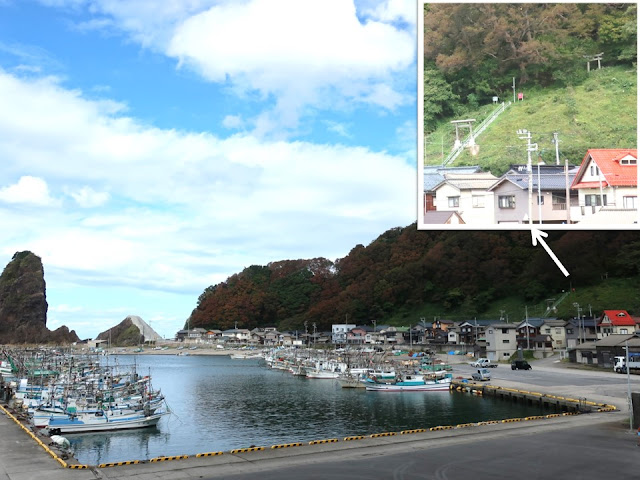Oshagiri festival museum (Murakami local museum) 、おしゃぎり会館(村上市郷土資料館)
Festive float is called “Oshagiri” in Murakami City, which is located in central Japan and is on the Japan Sea coast. Nineteen floats parade on the Murakami Grand Festival on the 7th of July. Three active Oshagiri are always in the museum.
新潟県の村上では、祭りの山車を「おしゃぎり」と呼んでいます。7月7日の村上大祭では19台のおしゃぎりが町を練り歩きます。円筒形の建物の中で、常時3台のおしゃぎりが展示されています。
It is said that the origin of the word “Oshagiri” is a festive music “Ohayashi”. It is also said it started in 1633. The photo above is Oshagiri on Uemachi town; there are musician dolls on the float.
「おしゃぎり」は、祭りの「お囃子」をさしていたものと思われる、と書かれていました。1633年に始まったといわれています。写真は、上町のおしゃぎりです。台車に乗った人たちが囃子方です。
We can have a full view of the exhibition room from the 2nd floor. There are “Arauma (unruly horses)” in center.
二階からは、おしゃぎりの展示を一望できます。展示室中央の人形は、「荒馬」です。
“Arauma” is a parade which imitates the lord’s procession in 1588; he returned to Murakami with guarding the sprit deity of Hagurosan. (In Japan, we can share a deity.) Fourteen horse dolls marshal three portable shrines. The photo on the upper left was taken in 1975.
荒馬は、1588年に村上城主が羽黒山の御分霊を報じて凱旋した時を模したものです。武将の馬印を立てた14騎の馬の人形が3基の神輿を先導します。左上のポスターは昭和50年のものです。
On the 2nd floor, the history of samurai battles in the medieval era is shown. It is an interesting idea that there is a window to see the ruin of Murakami Castle from the exhibition room.
二階では、武将たちの戦いの歴史が紹介されています。村上城跡(臥牛山135m)を望める場所に窓を付けているのがユニークです。
I went to a restroom before I left the museum. There is a notice in which a lord directs, “Get closer to me. Don’t be reserved!”. In a usual notice, it is written “Please get closer to the urinal (Don’t let a floor get dirty.)”. I smiled and followed the instruction.
退館前にトイレに行ったら、この表示。「はは~」という感じで、これまたユニークでした。
https://www.city.murakami.lg.jp/site/kanko/oshagiri.html (in Japanese), accessed in January, 2023
Nihonkai (Japan Sea) Parkline、日本海パークライン
It’s an around 60km coastline from Murakami to Tsuruoka (north of Murakami).
新潟県村上市から山形県鶴岡市までの日本海の海岸、約60kmです。
Senami onsen hot-spring resort、瀬波温泉
The hot-spring was found in 1904 while searching oil. (a guest room of “Taikanso” hotel)
1904年、石油掘削中に見つかった温泉です。大観荘さん客室。
New rice of Iwafune was served at dinner.
夕食には、美味しい岩船米(新米)が出されました。
I drove along the coast on the next day. The photo above is “Sasagawa-nagare”, which has 11km coast with strangely shaped rocks. The road is always beside the sea; it’s the best driving route in my life. A local said, "Before the road was constructed in the early 20th century, a postman pushed a bicycle under wave splash and went to the next village".
次の日は、日本海沿いを北に進みました。写真は名所の「笹川流れ」。延長11kmの海岸に奇岩が続きます。ずっと海のそばを走るので、私の中では過去最高のドライブコースになりました。昭和のはじめまでは、郵便局員が波にさらされながら自転車を押して通る難所だったそうです。船で行き来する村々が点在していたのですね。
Neya fishing port above is north of Sasagawa-nagare. There is a village shrine at the foot of the mountain; it watches over villagers. It’s a nostalgic landscape of a fishing village.
笹川流れの北の寝屋(ねや)の漁港。港と人々の暮しを見守る鎮守。原風景ですね。ここはまだ村上市です。
I went north and reached to the ruin of the famous checkpoint “Nezu-ga-seki”. It’s a border between Niigata and Yamagata Prefecture.
更に北に進むと、かつて越後と出羽の国境であったという鼠ヶ関があります。今は、新潟県と山形県の県境です。国道7号線のそばには、「史跡念珠関址」の碑がたっています。
I had a tai fish bowl at Nezu-ga-seki. It was fished at the port, therefore the meat was so fresh. We pour a soup (upper right) to the bowl finally. It is called "Tai cha-zuke."
鼠ヶ関のすぐ北側にある「道の駅 あつみ」では、鼠ヶ関漁港で揚がった魚を出してくれます。身がコリコリした鯛茶漬け、絶品でした。最初は、味噌と刺身でいただき、続いて醤油、最後に右上の出汁をかけていただきます。
Visited
in October, 2022
Previous post (neighboring museum): Murakami
cultural history museum、村上歴史文化館
Next post (museum in the neighboring prefecture, Yamagata): Chido Museum、致道博物館












Comments
Post a Comment